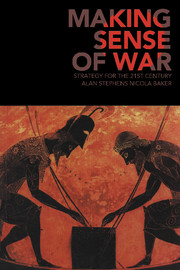Book contents
- Frontmatter
- Contents
- Abbreviations
- Preface
- Introduction
- Chapter 1 How to win
- Chapter 2 Stove-piped strategy
- Chapter 3 Traditional warfighting concepts and practices
- Chapter 4 Manoeuvre and the application of force
- Chapter 5 Shaping the strategic environment
- Chapter 6 Strategic paralysis
- Chapter 7 Contemplating war
- Chapter 8 Constraints on war
- Chapter 9 Controlling war
- Chapter 10 Peacemaking
- Chapter 11 War in the twenty-first century
- Notes
- Select bibliography
- Index
Introduction
Published online by Cambridge University Press: 05 June 2012
- Frontmatter
- Contents
- Abbreviations
- Preface
- Introduction
- Chapter 1 How to win
- Chapter 2 Stove-piped strategy
- Chapter 3 Traditional warfighting concepts and practices
- Chapter 4 Manoeuvre and the application of force
- Chapter 5 Shaping the strategic environment
- Chapter 6 Strategic paralysis
- Chapter 7 Contemplating war
- Chapter 8 Constraints on war
- Chapter 9 Controlling war
- Chapter 10 Peacemaking
- Chapter 11 War in the twenty-first century
- Notes
- Select bibliography
- Index
Summary
AT THE BEGINNING of the twenty-first century many long-standing strategic beliefs and practices appear to be under serious challenge, to the extent that some commentators have even declared ‘the end of strategy’.
There can be little doubt that the international environment is experiencing momentous change. The phenomenon of globalisation seems to be sweeping away national boundaries; the communications and information revolution is redefining who relates to whom, how, when and where, again on a global basis; and the ‘market’ may be superseding the ‘nation’ as the basis of statehood. Those secular pressures are undermining the nation-state but ironically contributing to a resurgence in the innately exclusive and often antagonistic phenomenon of nationalism. A new element of uncertainty and insecurity has been introduced by al-Qa'ida's stunning attack on New York City and Washington on September 11, 2001 and the rise more generally of the incidence of suicide bombing.
Simultaneously, the potential for the large-scale, theatre-level wars between nations that have shaped both the nature of conflict and the structure of defence forces for centuries seems to be diminishing. The Korean Peninsula, the Taiwan Straits, and Israel and the Middle East remain dangerous flashpoints, but major inter-state wars have generally been on the decline. Following a Cold War that ended with a whimper not a bang, the number of armed conflicts around the world between 1991 and 2003 decreased by more than 40 per cent, international crises declined by 70 per cent, and expenditure on international arms transfers fell by 33 per cent.
- Type
- Chapter
- Information
- Making Sense of WarStrategy for the 21st Century, pp. ix - xivPublisher: Cambridge University PressPrint publication year: 2006

